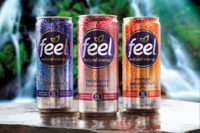Energy Addiction

With an estimated $6.6 billion in sales in 2007, energy beverages have emerged as a genuine trend, as sales have increased 440% since 2002, notes a Packaged Facts report. The segment, as a whole, is further expected to grow at an annual rate of 12%, to surpass $9 billion by 2011.
While Mintel’s estimate of the market size differs, estimating the July 2008 segment’s sales at $4.8 billion, it does agree that energy drinks have seen more than 400% sales growth since 2003. Furthermore, Mintel finds a greater number of consumers buying the beverages: in 2003, 9% of respondents to a Mintel survey said they consume energy drinks; by 2008, the percentage stood at 15%, with the greatest growth among teenage consumers. Some 35% of that demographic regularly consume energy drinks, a sizable increase from the 19% stating the same in 2003.
The younger age group is the definite target for Purple Stuff from Funktional Beverages. As the company’s chief marketing officer Tim Lucas notes, “The consumer profile for Purple Stuff shows the majority are in the 13-25 age group, with 51% being females.” Interestingly, Funktional promises the beverage is a take on energy drinks, though with a different goal: relaxation. At the same time, company founders describe it as a vitamin soda and a relaxation drink. Its ingredient list includes crystalline fructose, rosehips and valerian root, as well as the amino acid L-theanine, but no high-fructose corn syrup or caffeine.
Many energy drinks sit on the fence in regards to being a beverage (which is a food, by FDA standards) or a dietary supplement, which would allow for a wider range of innovative ingredients under FDA regulations. Simple caffeine is one of the more prominent and sometimes controversial ingredients in many energy drinks.
Caffeine, a legal, psychoactive central nervous stimulant with GRAS status in the U.S., has the well-known ability to ward off drowsiness. Its biological effects include a reported ability to increase neurotransmitters, such as serotonin, GABA and catecholamines, among others. Results have been mixed, in regards to its ability to enhance physical or mental performance. For example, published research that supports caffeine’s sports performance advantages includes a paper titled, “Improved Cycling Time-trial Performance After Ingestion of a Caffeine Energy Drink” (Kammer L, et al. 2009. Int J Sport Nutr Exerc Metab. 19(1):61-78). Another widely referred to study found caffeine improved short-term memory and possibly increased reaction times (see www.rsna.org/rsna/media/pr2005/Coffee.cfm). However, other studies have not always been so supportive.
Funktional Beverage’s efforts in the energy drink arena are fairly diverse, as another recent launch promises weight management benefits. Supraliminal Labs’ Red Stuff with LuraLean is described as a hybrid drink, combining energy, appetite control, calorie burners and “100% natural GRAS fiber.” The Sippin Citrus variety incorporates a blend of crystalline fructose and sucralose into a “calming elixir,” so dubbed due to its use of valerian root, rosehip and L-theanine, as well as its lack of caffeine. The company notes the rosehip powder “contains more vitamin C than an orange,” and it offers relief for osteoporosis.
“The benefits are multi-faceted,” explains Lucas, “and the science behind our brands is strong. The functionality of an appetite suppressant and lipid metabolism booster appeals to consumers looking for a sports endurance beverage, and that is what they get with Red Stuff. Color represents the function of the product. Purple is our relaxation/anti-anxiety line of products. Everything Red is our energy/weight-loss/metabolism line.”
Sweet On
Sweeteners have been a source of much discussion in recent years, with studies suggesting detrimental effects for some, while other studies note the safety and benefits of artificial and natural sweeteners alike.
Polyols, with their special and individual properties, are occasionally found in energy drinks. For example, NOW Shots B-12 10,000mcg Energy Boost, recently introduced into the U.S., contains xylitol as well as fructose for sweetening. Xylitol is about as sweet as sucrose, though with only 2.4Kcal/g; plus, bacteria in the mouth cannot ferment it, making it “tooth friendly.”
The popularity of a polyol, or any nutrient in energy drinks, can vary widely by country. For example, erythritol is positioned as a natural sweetener. Commercially, it is fermented from glucose by yeast and is naturally present in fruits and other fermented products. It is 60-70% as sweet as sucrose, but its calorie content varies from country to country. That is, under FDA labeling requirements, it has a very low caloric value of 0.2Kcal/g (compared to about 4.0 for sucrose and starches). In Japan, it is labeled as having zero calories, while under EU regulations, it is considered to have 2.4Kcal/g.
Although erythritol is not commonly used in energy drinks in the U.S., it can be found in a number of Japanese products. Examples include the April 2010 launch of Meiji Seika Kaisha’s Perfect Plus Diet Muscat Energy Gelee, “with four types of vitamins, digestive fiber and calcium,” according to Mintel’s GNPD. The dietary fiber comes in the form of “indigestible dextrin and konjac extract,” calcium from calcium lactate, and calcium chloride and additional sweetness provided by acesulfame-K and sucralose.
While that launch added fiber, Protegy from Distinct Beverages emphasized protein enrichment. This carbonated protein energy drink combined two features key to fitness enthusiasts. Protegy included 25g of pure whey protein isolate and a blend of caffeine, ginseng, B vitamins, pomegranate and açai berry extracts. The lactose-free beverage also promises no carbohydrates or sugar.
Worldwide Sports Nutrition’s Pure Protein likewise incorporates protein into an energy drink, with its Supreme Whey Shot with BCAAs. The 3.2oz, fruit punch-flavored energy shot boasts 50g of protein and no sugars.
While these target fitness enthusiasts, Monster Beverages clearly had automobile racing fans in mind for its launch of Nitrous Monster. Available in Super Dry, Killer-B and Anti Gravity varieties, the company says it was the first energy drink to boast nitrous oxide gas technology, to provide a “creamy texture and a smooth flavor.” At the same time, the company undoubtedly hoped to capitalize on the targeted demographic group’s ability to understand that nitrous oxide can enhance engine power. The beverage boasted an array of B vitamins (3.4mg of B2, 40mg of B3, 4mg of B6 and 12mg of B12), as well as 2,000mg of taurine.
Taurine is a key component of many energy drinks. It is actually an “amino acid-like molecule,” since it lacks the carboxyl group typical of true amino acids. It was first isolated from ox bile, thus its name is derived from the Latin word Taurus, for ox or bull. It is an antioxidant and also important to many metabolic processes. One 2004 study found it helps prevent exercise-induced oxidative stress (Zhang M, et al. 2004. Amino Acids. 26(2):203-7). The website MayoClinic.com reports that, while certain studies support taurine supplementation as a way to improve athletic performance, some of these findings remain undecided. The website also relays that up to 3,000mg per day of supplemental taurine is safe.
Energizing Alcohol
Energy beverages have invited controversy in recent years, with products that combine stimulants with alcohol. Stimulants are contributed from a variety of frequently used ingredients that may be unfamiliar to consumers. (See chart “Counting Caffeine.”) Concerns over the safety of these products, however, have not curtailed alcoholic energy beverage introductions. Earth Beverages launched such a concoction under its World Series of Poker brand. The “energized” cocktail mixers were in partnership with Harrah’s Casino and the World Series of Poker and were released along with a line of energy shots under the same brand. The former allowed the creation of energized versions of classic cocktails, such as Bloody Marys, Mai Tais, Margaritas, Mojitos and Pina Coladas, while the energy shots were geared more toward impulse purchases, noted the company.
Energy beverages also have striven to be healthier, as they have featured 50 or 60% juice. PepsiCo took its AMP Energy Juice one step further, featuring a 100% juice base. Its Orange and Mixed Berry varieties both boast 120mg of caffeine, as well as taurine, guarana seed extract and Panax ginseng root extract. (More detail is provided in the chart, “Formulating Energy,” which has information from the product’s Canadian label.) The company appears to be positioning the beverage as a breakfast addition, judging by comments from Dave Mingey, vice president of marketing with AMP Energy. “Many core consumers told us they weren’t interested in coffee to solve their morning energy needs. They needed something that went beyond traditional energy drinks. So, we’re answering their calls for more energy options by introducing AMP Energy Juice.”
The group has also unveiled a pair of other introductions under the AMP brand. AMP Energy Sugar-free Lightning Drink has a lemonade flavor but claims to be the first sugar-free flavored energy drink. Energizing ingredients are by no means limited to beverages, either; AMP Energy has introduced an energy gum with a light citrus flavor and a blend of B vitamins, taurine and caffeine.
The company also capitalized on tea’s popularity by introducing AMP Energy Drink with Black Tea in Canada. The energy drink, which is also available in green tea and lemonade varieties, promises to “promote wakefulness when experiencing fatigue or drowsiness.” Developed “for periods of increased mental and physical exertion,” its formula incorporates guarana (296mg), taurine (292mg), ginseng (33mg) and 700mg of the amino acid beta-alanine, as well as certain B vitamins (39.4mg of B3, 16mg of B5 and 6.1mg of B6).
Vitamin B6 and B12 are frequently in many energy products. Vitamin B6 (aka, pyridoxine, or in foods, often as pyridoxal phosphate [PLP]) is water-soluble, which means it is not stored in the body like fat-soluble vitamins. Among other roles, PLP is required for the enzymatic reaction governing the release of glucose from glycogen, a carbohydrate in which the muscles and other human tissues store energy. The website of 5-Hour Energy shot simply reports that it “aids in the processing of carbohydrates for energy.”
Vitamin B12 (i.e., various cobalamin forms, commonly as cyanocobalamin) is also water-soluble. Perhaps the most important biochemical reaction in the human body in which it is involved is actually the conversion of homocysteine to the amino acid methionine. A deficiency of B12 blocks DNA synthesis. It is involved in the metabolism of lipids and carbohydrates, which 5-Hour Energy picks up on, as it notes: “B12 also participates in...the processing of carbohydrates into energy.”
Despite the rapid growth of the energy beverage segment, both in terms of sales and introductions, there remains room to grow. The market targets men almost exclusively--and young men, at that. Only 11% of women consume energy drinks, according to “Energy Drinks & Energy Shots--U.S.,” a July 2009 report from Mintel. That same report found women utilize energy drinks for a different purpose than men; women consume them “to stay awake,” while men enjoy them “for taste,” “as a refreshment,” for “hydration” or to “improve sports performance.” New introductions capitalizing on these reasonings could well propel an introduction to success in a fairly fragmented segment. pf
Looking for a reprint of this article?
From high-res PDFs to custom plaques, order your copy today!

 Claudia Dziuk O'Donnell is Chief Editor and Associate Publisher of Prepared Foods magazine including its NutraSolutions and Culinary sections. Her responsibilities include determining the editorial content of the print publication and the New Products Conference.
Claudia Dziuk O'Donnell is Chief Editor and Associate Publisher of Prepared Foods magazine including its NutraSolutions and Culinary sections. Her responsibilities include determining the editorial content of the print publication and the New Products Conference.




